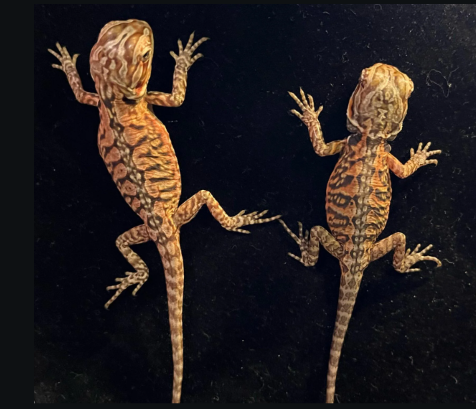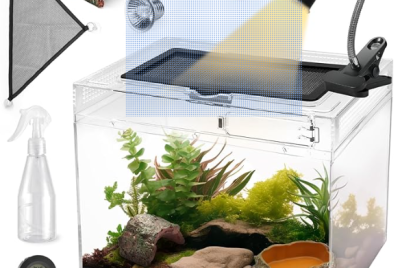Silkback Bearded Dragon (Silkies): A Complete Care Guide
If you’re a bearded dragon enthusiast like me, you may have come across the term “Silkback” or “Silkie.” These unique bearded dragons are known for their scaleless bodies, giving them a soft, silky texture. But, before you rush to add one of these amazing creatures to your reptile family, let me guide you through everything you need to know about caring for a Silkback bearded dragon. From their genetics to their unique care requirements, I’ll cover it all!
Introduction to Silkback Bearded Dragons
Silkbacks are a special morph of the classic bearded dragon (Pogona vitticeps), bred to have smooth, scaleless skin. While they share many similarities with regular bearded dragons, they also have specific needs due to their lack of scales. Let’s dive deeper into what makes Silkbacks stand out and how to care for them properly.
What Are Silkback Bearded Dragons?
If you’ve never seen a Silkback before, you might be curious about what makes them different from other bearded dragons.
The Genetics Behind the Silkback Morph
Silkback bearded dragons are created through selective breeding. The scaleless trait is a result of breeding two leatherback dragons (a morph with fewer scales). The offspring of these dragons may carry the scaleless gene, resulting in a smooth-skinned Silkback. It’s a fascinating genetic variation that creates a truly unique reptile.
Silkback vs. Regular Bearded Dragons
While regular bearded dragons have rough, spiky scales, Silkbacks have none of that. This gives them a sleek, smooth appearance that’s quite striking. However, this also makes them more sensitive to environmental conditions, as their skin lacks the protective layer of scales that regular bearded dragons have.
Unique Appearance of Silkbacks
One of the biggest reasons people are drawn to Silkbacks is their appearance. The lack of scales gives them a completely different look and feel from other morphs.
The Scaleless Feature
Without scales, Silkbacks feel almost velvety to the touch. This smooth texture is one of their defining characteristics, but it also makes them more prone to injury, sunburn, and dehydration. Their skin is much more fragile than that of a standard bearded dragon, so extra care is necessary.
Color Variations in Silkbacks
Silkbacks can come in a variety of colors, just like regular bearded dragons. The smooth skin often makes their colors appear brighter and more vibrant. Whether it’s shades of orange, yellow, or even deep red, Silkbacks are a sight to behold. The lack of scales means their coloration shines through in a more intense way.
Temperament of Silkback Bearded Dragons
In terms of personality, Silkies are quite similar to other bearded dragons. They are generally docile, friendly, and curious.
Behavioral Traits Compared to Other Bearded Dragons
Silkbacks tend to be just as calm and easygoing as regular bearded dragons. However, their delicate skin can make them a bit more cautious. They may not be as adventurous because they are more susceptible to injuries from rough surfaces.
Interacting with Humans
Silkbacks love interacting with their human companions. They enjoy being handled, but you need to be gentle with them. Due to their scaleless skin, they are more prone to damage from rough handling. Always wash your hands before holding them, as their skin can absorb oils and bacteria more easily than scaled dragons.
Housing and Habitat for Silkback Bearded Dragons
Like any bearded dragon, Silkies need a comfortable and well-maintained habitat to thrive. However, due to their unique skin, there are a few additional considerations.
Ideal Enclosure Size
For an adult Silkback, you’ll need an enclosure that’s at least 40 gallons, but bigger is always better. Make sure the enclosure has plenty of space for them to roam and explore. Silkbacks are less likely to climb than their scaled cousins, so focus on floor space rather than height.
Heating and Lighting Requirements
Silkies need the same heat and UVB lighting as regular bearded dragons. A basking spot that reaches temperatures between 95°F to 110°F is essential. However, be mindful that their scaleless skin makes them more vulnerable to sunburn. Make sure their UVB light isn’t too strong and provide plenty of shaded areas for them to retreat.
Humidity and Moisture Needs
Humidity levels should stay between 20-40%, as Silkbacks can be prone to respiratory issues in higher humidity environments. Keep the enclosure well-ventilated, and ensure that it remains dry most of the time.
Feeding and Nutrition for Silkbacks
Diet is another key component to keeping your Silkback healthy. Thankfully, their dietary needs aren’t much different from regular bearded dragons.
Recommended Diet
Silkbacks thrive on a diet of leafy greens, vegetables, and live insects such as crickets, dubia roaches, and mealworms. For adult Silkbacks, aim for a diet of 70% greens and 30% insects. For younger dragons, the balance shifts to more insects to support growth.
Hydration Tips for Silkies
Since Silkies are prone to dehydration due to their lack of scales, you should provide fresh water daily. Mist them occasionally to help with hydration, but don’t overdo it—too much moisture can lead to skin problems.
Skin Care for Silkback Bearded Dragons
Caring for a Silkback’s skin is probably the most significant difference between them and regular bearded dragons. Their smooth skin requires extra attention to prevent issues.
Moisturizing Their Skin
Silkback bearded dragons can develop dry skin more easily than their scaled counterparts. I recommend using a reptile-safe moisturizer occasionally, especially if you notice their skin becoming dry. Regular baths in lukewarm water also help keep their skin hydrated and healthy.
Handling Shedding Issues
Shedding can be more challenging for Silkbacks. Without scales, their skin doesn’t shed as easily, and you’ll need to be mindful of stuck shed, which can cause irritation. Regular baths can help with shedding, and you can gently assist by rubbing off loose skin, but never force it.
Common Health Concerns for Silkbacks
While Silkbacks are generally healthy, their scaleless skin makes them more prone to certain health issues that owners need to be aware of.
Sunburn Risks and Prevention
Due to their delicate skin, Silkbacks are at a much higher risk of sunburn. Make sure they aren’t exposed to direct sunlight for long periods. In their enclosure, ensure there are shaded spots to escape the UVB light if needed.
Dehydration in Silkbacks
Because their skin isn’t as efficient at retaining moisture, dehydration is a real concern for Silkbacks. Monitor their water intake, mist them regularly, and provide baths to help them stay hydrated.
Breeding Silkback Bearded Dragons
Breeding Silkbacks requires a bit more knowledge and care than other bearded dragons.
Breeding Silkies: What You Need to Know
Breeding two Silkbacks together is not recommended due to potential health issues in the offspring. Instead, Silkies are typically bred with leatherbacks or regular bearded dragons to produce healthier babies. Breeding Silkies requires careful planning, as their genetic makeup can result in complications.
Is a Silkback Bearded Dragon Right for You?
Before bringing a Silkback into your home, it’s essential to consider their care requirements. Their unique needs make them better suited for more experienced reptile owners who are ready for the extra care and attention they require.
Understanding Their Special Needs
Silkies are undoubtedly fascinating pets, but their scaleless nature means they need more careful handling, attention to their habitat, and consistent skin care. If you’re willing to invest the time and effort, they can be an incredibly rewarding pet.
Conclusion
Silkback bearded dragons, or Silkies, are a remarkable morph that requires special attention due to their scaleless skin. While they may need more care than regular bearded dragons, their unique appearance and friendly temperament make them a joy to own. If you’re prepared for their specific needs, a Silkback can be a fantastic addition to your reptile family.
FAQs
1. Do Silkback bearded dragons need special lighting?
A: Yes, they require UVB lighting like other bearded dragons but are more prone to sunburn, so ensure they have shaded areas in their enclosure.
2. How often should I moisturize my Silkback bearded dragon?
A: You can moisturize their skin once a week with a reptile-safe product, especially if they are shedding or their skin looks dry.
3. Can Silkbacks live with other bearded dragons?
A: It’s not recommended to house Silkbacks with other dragons, as they have more delicate skin and can be injured during interaction.
4. How do I prevent sunburn in my Silkback bearded dragon?
A: Provide shaded areas in their enclosure and monitor their time under UVB lighting to avoid overexposure.
5. Are Silkback bearded dragons more expensive than regular bearded dragons?
A: Yes, due to their unique appearance and special care requirements, Silkbacks tend to be more expensive than standard bearded dragons.




